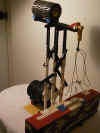Site map :
 
Last upgrade to the site:
august 10th, 2002.

There has been

access to my Lego pages since creation.
 
This is an unofficial LEGOŽ web site.
LEGOŽ is a trademark of the LEGOŽ Group of companies
which does not sponsor, authorize or endorse this site.
You can visit the official LEGO website at: http://www.lego.com
Copyright 1996, 2000, Denis Cousineau
| |
-
How to measure the strength of a pneumatic?
In fact, it is not the strength of a pneumatic that we will measure, but the
strength of the pump (or the tank) working behind. By attaching a weight to the
pneumatic and varying it, we are looking for the point of equilibrium, the point
where the weight exactly compensates the pull from the pressure tank. By
measuring this critical mass, we obtain the strength of the pressure generated
by the pump.
Below is a picture of the measuring device.

We measured the strength of the following pumps:
Type of compressor
|
It can lift
|
| i) |
The small pump |
342 bricks |
855 grams |
| ii) |
The large pump with the pressure regulator |
360 bricks |
900 grams |
| iii) |
The large pump without regulator |
622 bricks |
1555 grams |
| iv) |
The car pump |
it was not available, but we suspect it can blast the above
values easily. |
The pressure regulator I designed limits the pressure to be less than 900
grams while it could be as large as 1500 grams. This is the point of introducing
a security device: avoid overflow. At about 2000 grams, the hoses start popping
out of the sockets.
-
What is the reaction time of a pneumatic?
Pneumatics dont react instantly. The main factors are the pressures in the
hoses (generated from the pump, and maintained in the tank), and the length of
them.

We tested with a hose of 3 m. If the switch is close to the tank, reaction
time is slower than when the switch is close to the application. This is because
the hose itself must be under pressure. When the switch is next to the
application, the hose is already under pressure and ready to push the pneumatic.
Position of the switch Time to expand fully the pneumatic
| Close to the pneumatic 0.25 seconds |
| Far from the pneumatic 0.50 seconds |
As seen the difference is not large, around a quarter of a second. However,
this difference increase if the number of pneumatics turned on at the same time
is large.
|







